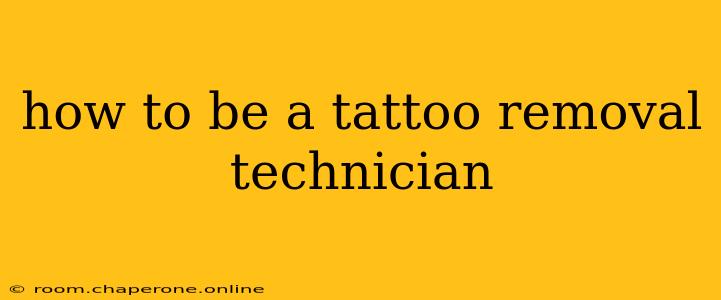Getting unwanted ink removed is a growing industry, and with that comes a surge in demand for skilled tattoo removal technicians. This comprehensive guide outlines the necessary steps to pursue a career in this exciting and in-demand field. Becoming a proficient technician requires dedication, training, and a keen eye for detail. Let's dive in.
1. Education and Training: The Cornerstone of Success
While specific licensing requirements vary by location (always check your state/province/country regulations!), formal training is paramount. This isn't a field you can simply learn through online videos; proper technique is crucial for patient safety and effective results.
Types of Training Programs:
- Medical Aesthetics Schools: Many vocational schools and colleges offer comprehensive courses in medical aesthetics, which often include modules on laser tattoo removal. These programs typically combine theoretical knowledge with hands-on practical training. Look for programs accredited by relevant professional organizations.
- Laser Technology Certification: Dedicated laser technology certification programs focus specifically on the operation and maintenance of laser equipment used in various medical aesthetics procedures, including tattoo removal. This specialized training is highly valuable.
- Apprenticeships: Some established clinics or medical spas might offer apprenticeships or mentorship programs. This hands-on approach, under the guidance of experienced technicians, can provide invaluable practical skills and industry insights. This is a less common route, but it can be highly beneficial.
2. Mastering the Techniques: Beyond the Basics
Effective tattoo removal requires a thorough understanding of several key areas:
Laser Technology:
Understanding the different types of lasers (e.g., Q-switched lasers, picosecond lasers), their mechanisms of action, and their applications for various ink colors and skin types is crucial. You'll need to learn how to adjust laser parameters based on individual patient needs and tattoo characteristics.
Skin Anatomy and Physiology:
A solid grasp of skin structure and function is essential to performing safe and effective treatments. Understanding how lasers interact with different skin layers and potential complications is vital for minimizing risks.
Patient Assessment and Consultation:
Proper patient assessment is critical. This includes reviewing medical history, evaluating tattoo characteristics (age, depth, color, ink type), and managing patient expectations. You'll need excellent communication skills to provide informed consent and address any concerns.
Post-Treatment Care:
Providing clear and detailed post-treatment care instructions is vital for optimal healing and minimizing the risk of complications. This includes explaining potential side effects and addressing any patient questions.
3. Licensing and Legal Requirements: Navigating the Regulations
The regulatory landscape for tattoo removal technicians varies significantly depending on your location. Some jurisdictions require specific licenses, certifications, or registrations to practice. Others might have less stringent regulations. Always research and comply with all applicable laws and regulations in your area. This may involve obtaining state or national licenses and adhering to health and safety standards.
4. Building Your Career: Experience and Networking
Gaining practical experience is key. Seek opportunities to assist experienced technicians, volunteer at relevant clinics, or consider working in a related field (e.g., medical aesthetics) to build your skillset. Networking within the industry through professional organizations and attending conferences can also be beneficial for career advancement.
5. Continual Learning and Professional Development
The field of tattoo removal is constantly evolving with advancements in laser technology and treatment techniques. Continual professional development is essential to staying current with the latest best practices and maintaining a high standard of care. Attend workshops, conferences, and continuing education courses to enhance your knowledge and skills.
Conclusion: Embarking on Your Journey
Becoming a successful tattoo removal technician requires dedication, thorough training, and ongoing professional development. By carefully following the steps outlined above, and by consistently prioritizing patient safety and effective treatment, you can build a rewarding and fulfilling career in this growing field. Remember to always check your local regulations and seek out reputable training programs. The path may be challenging, but the rewards are significant for those who are passionate and committed to mastering this specialized skill.

